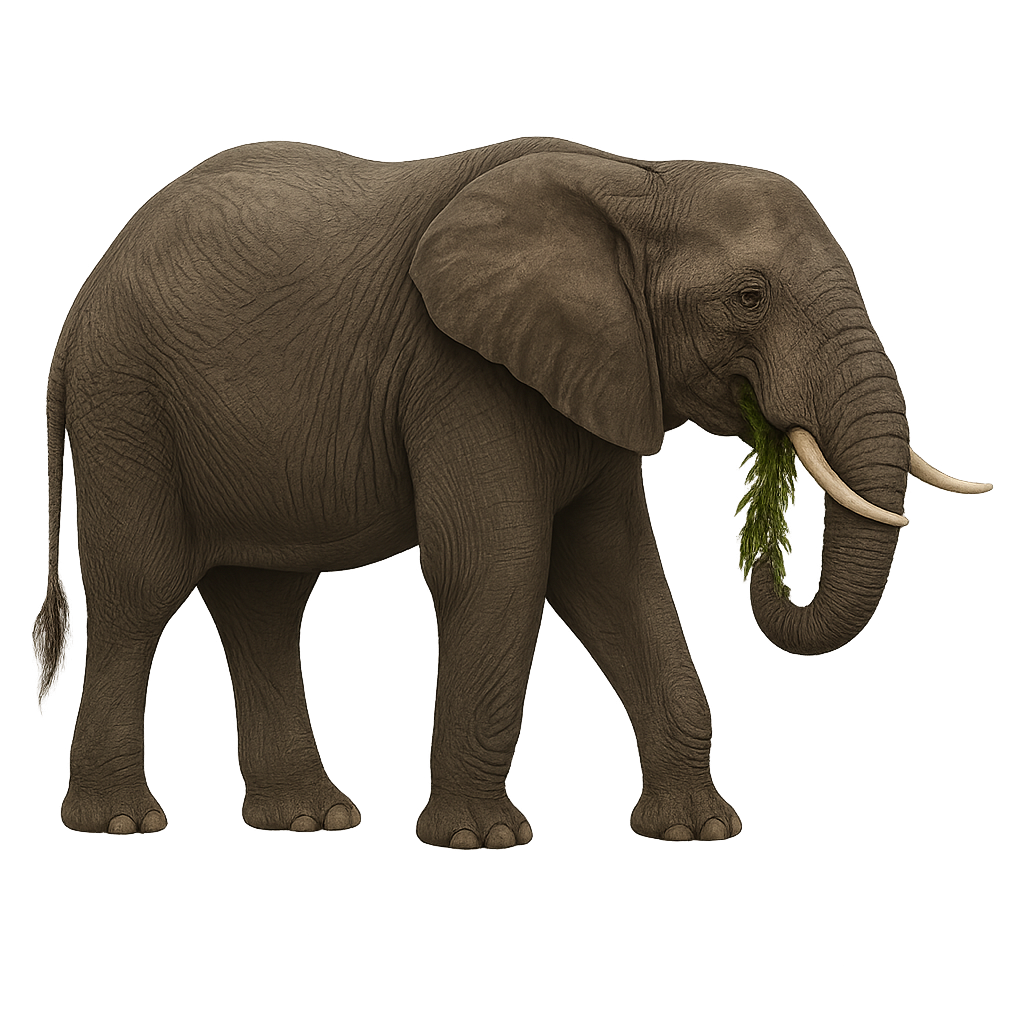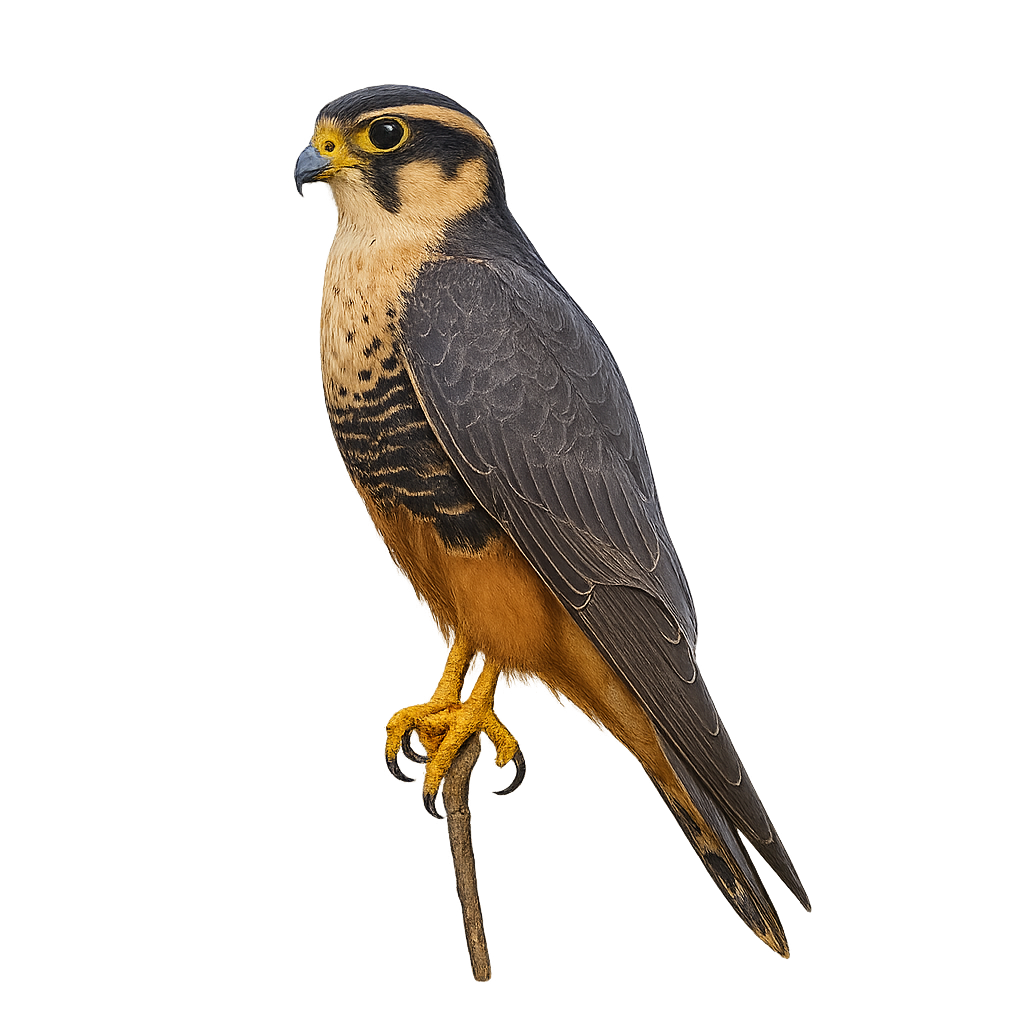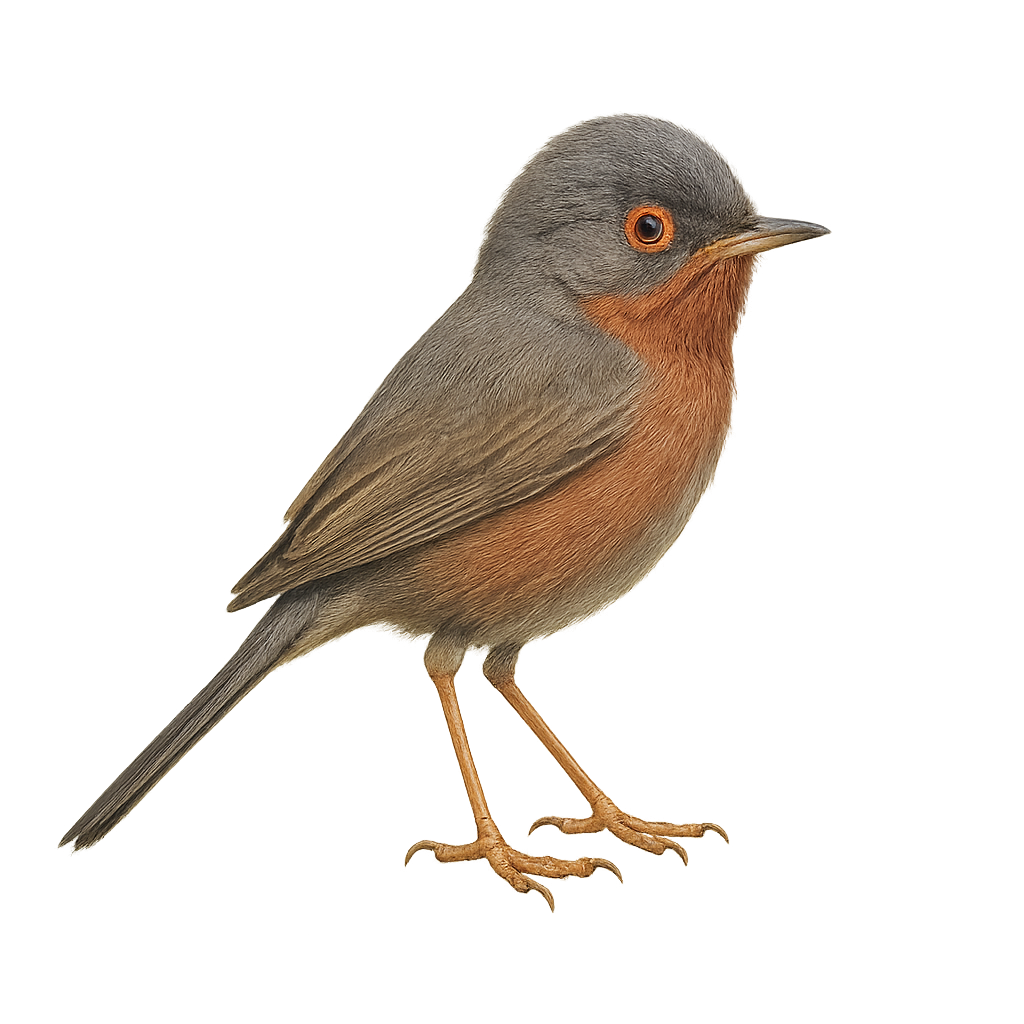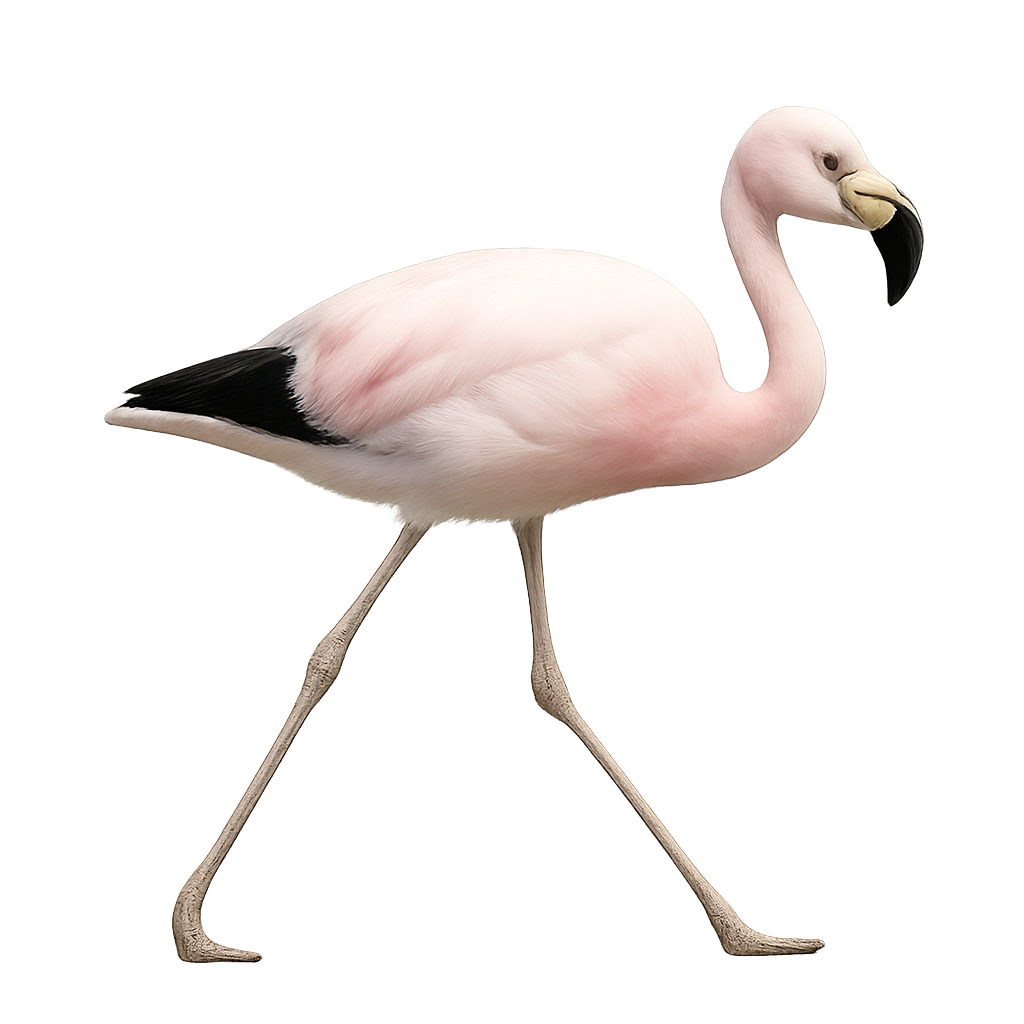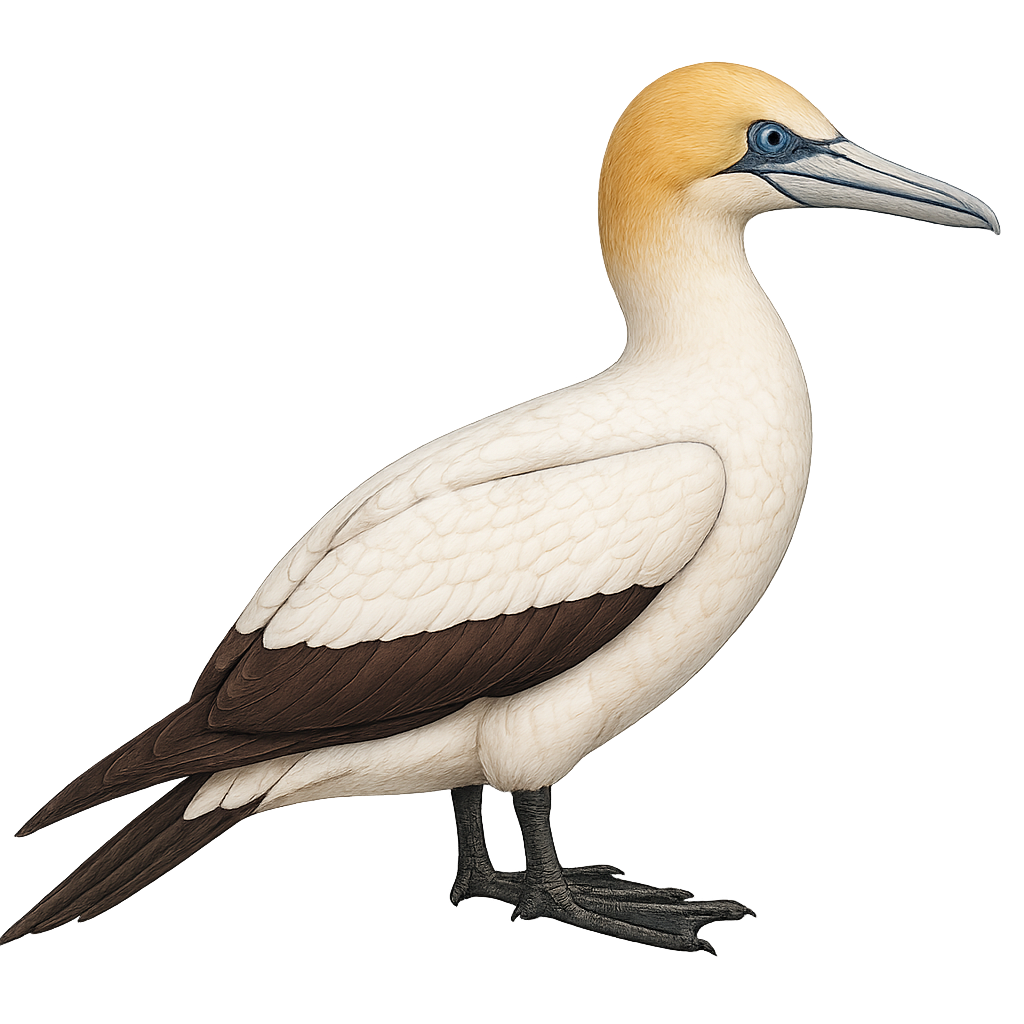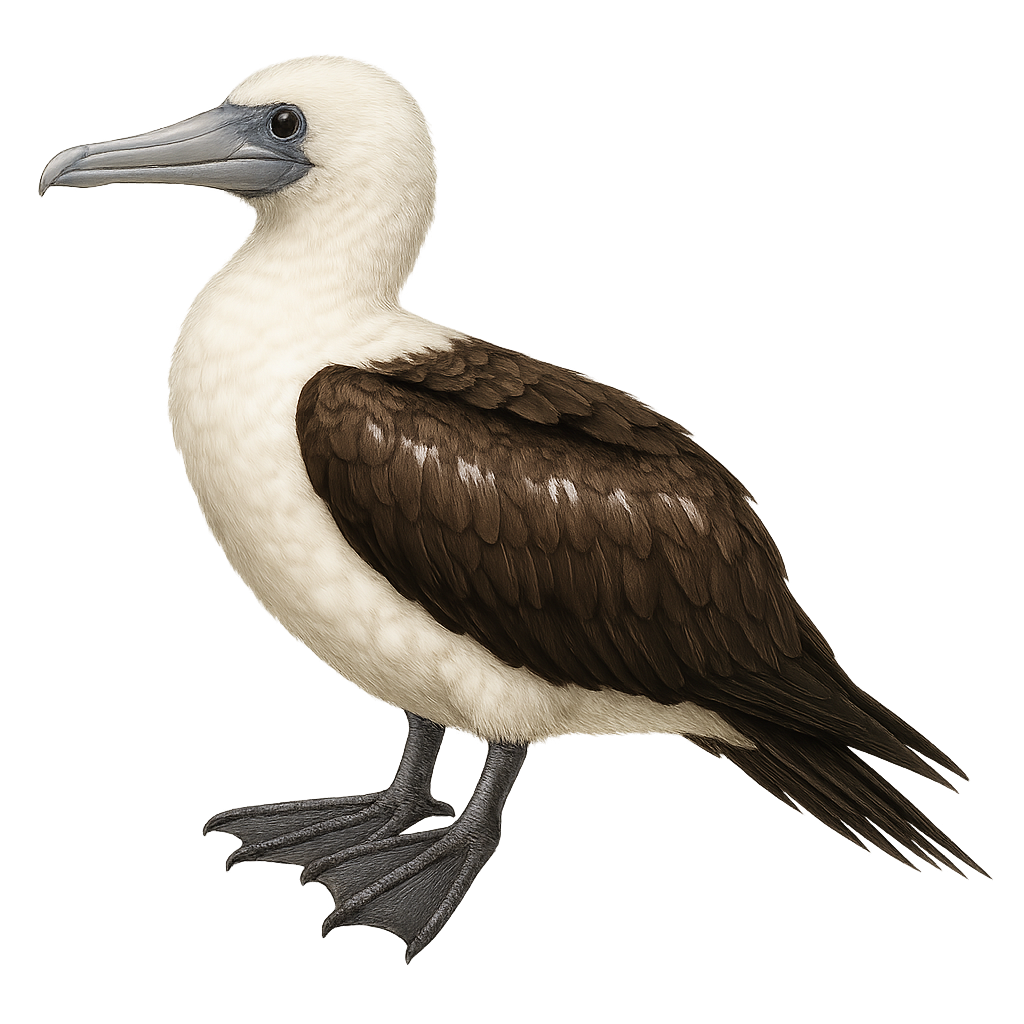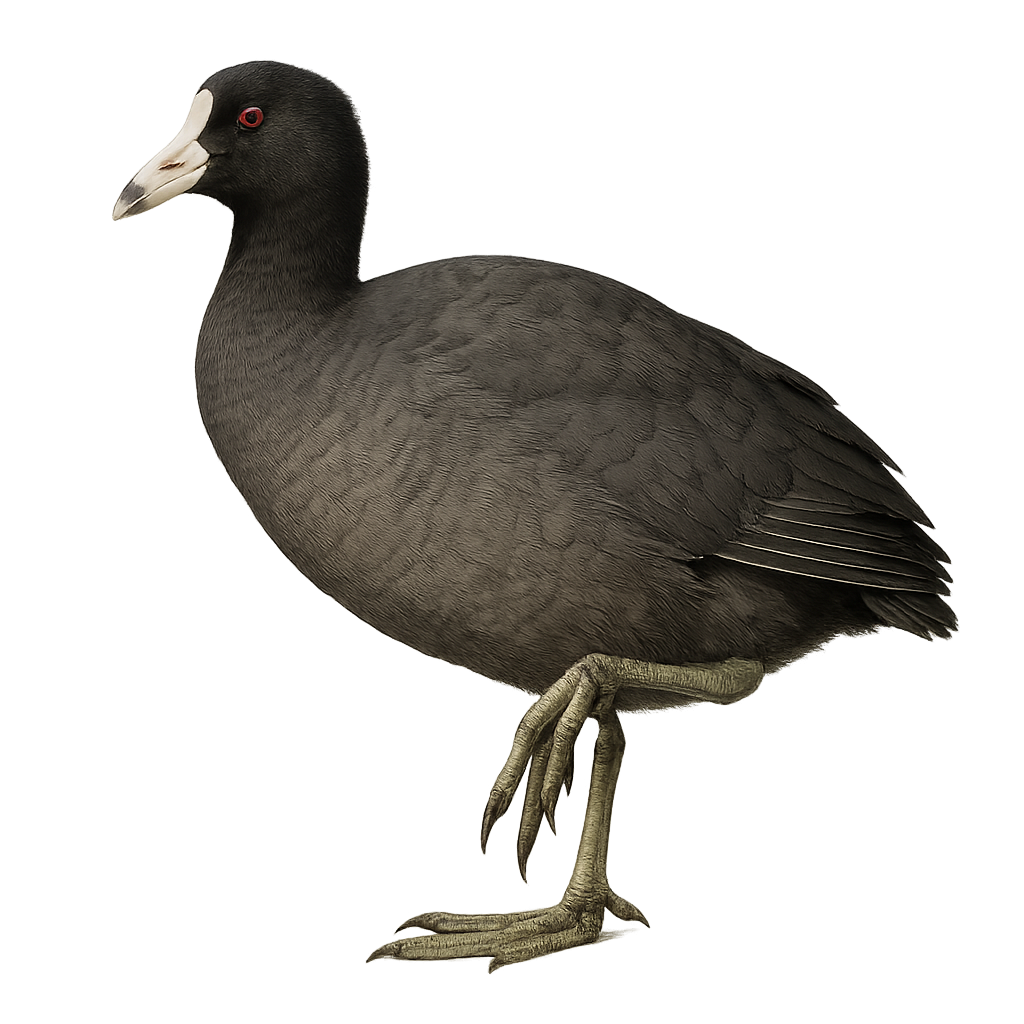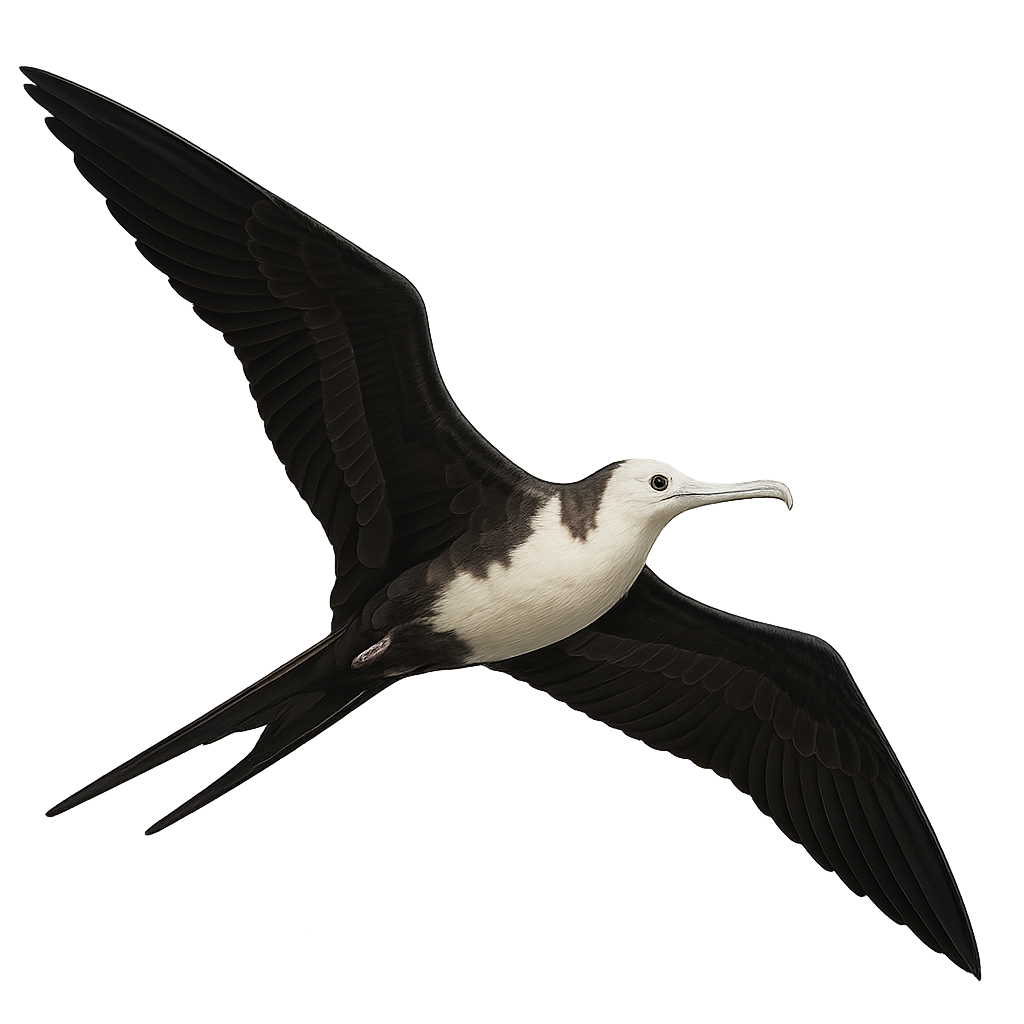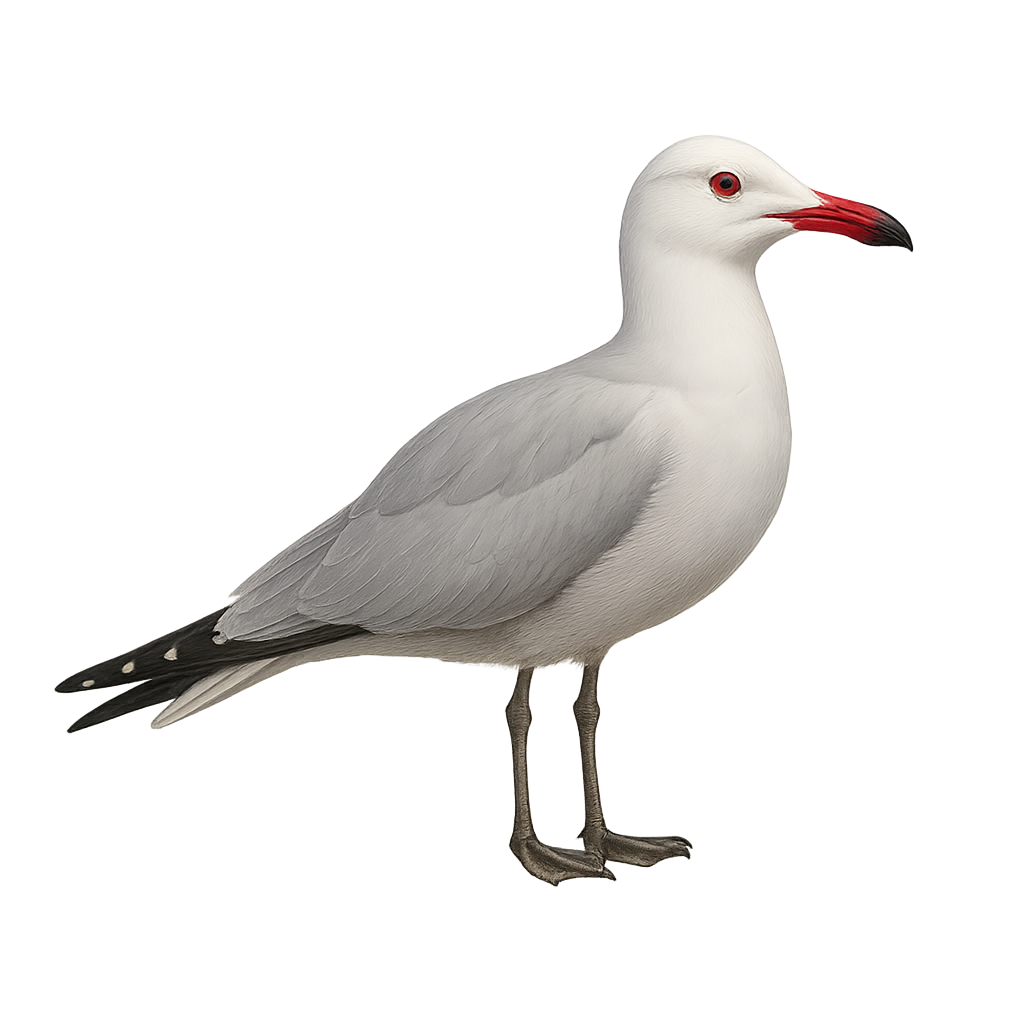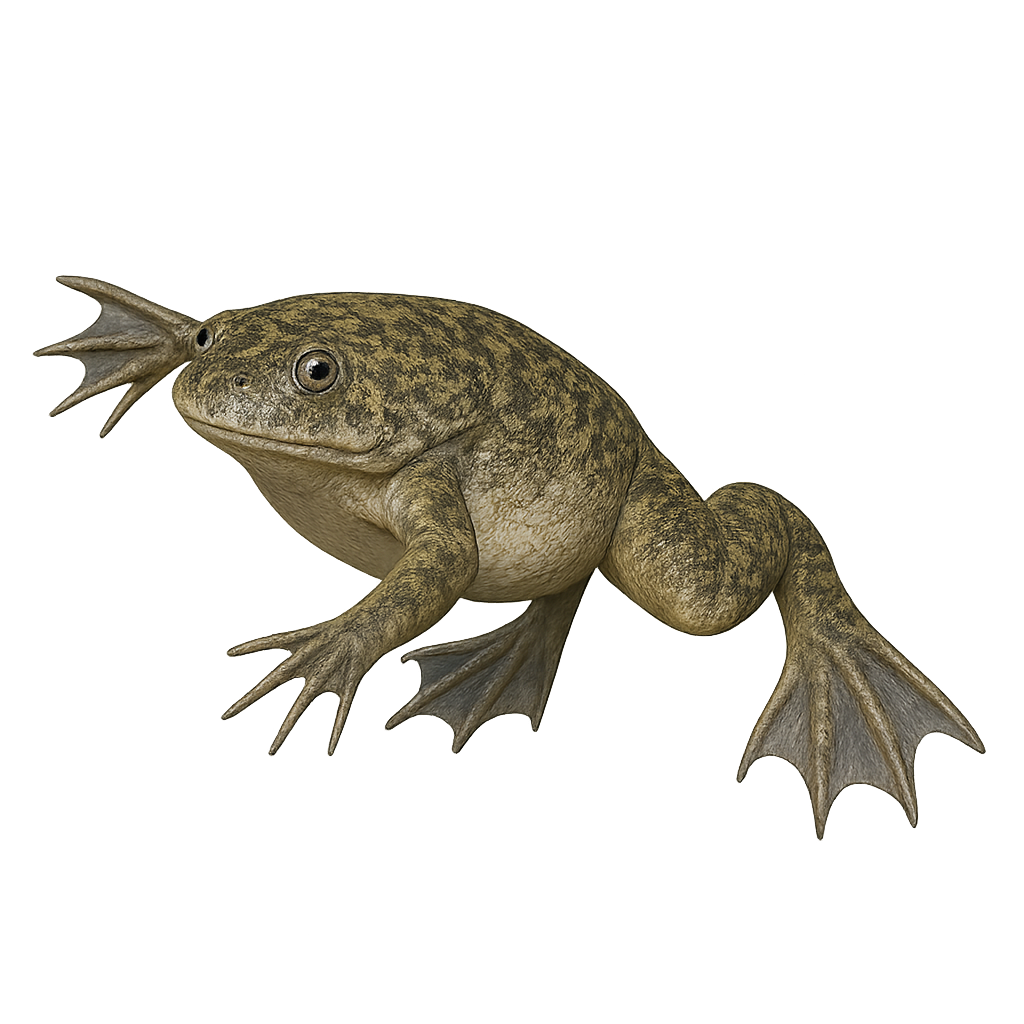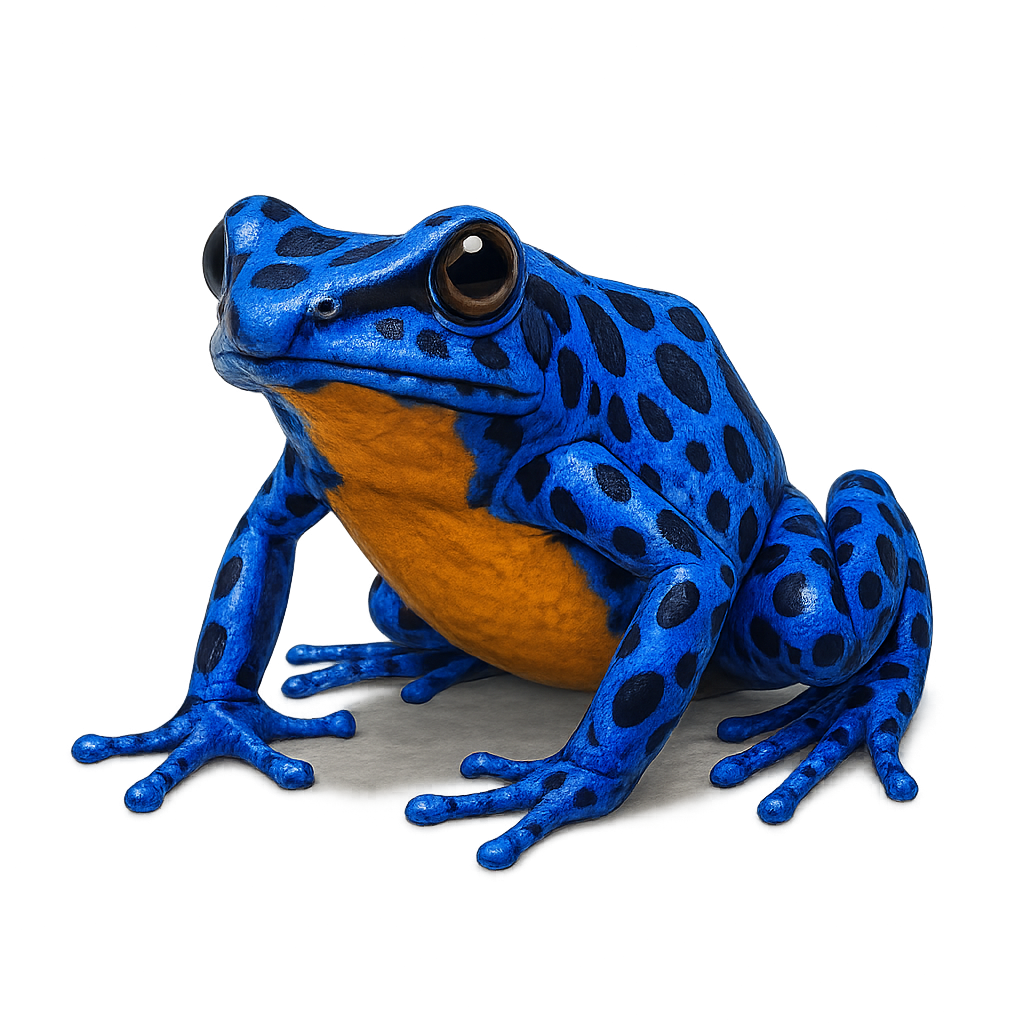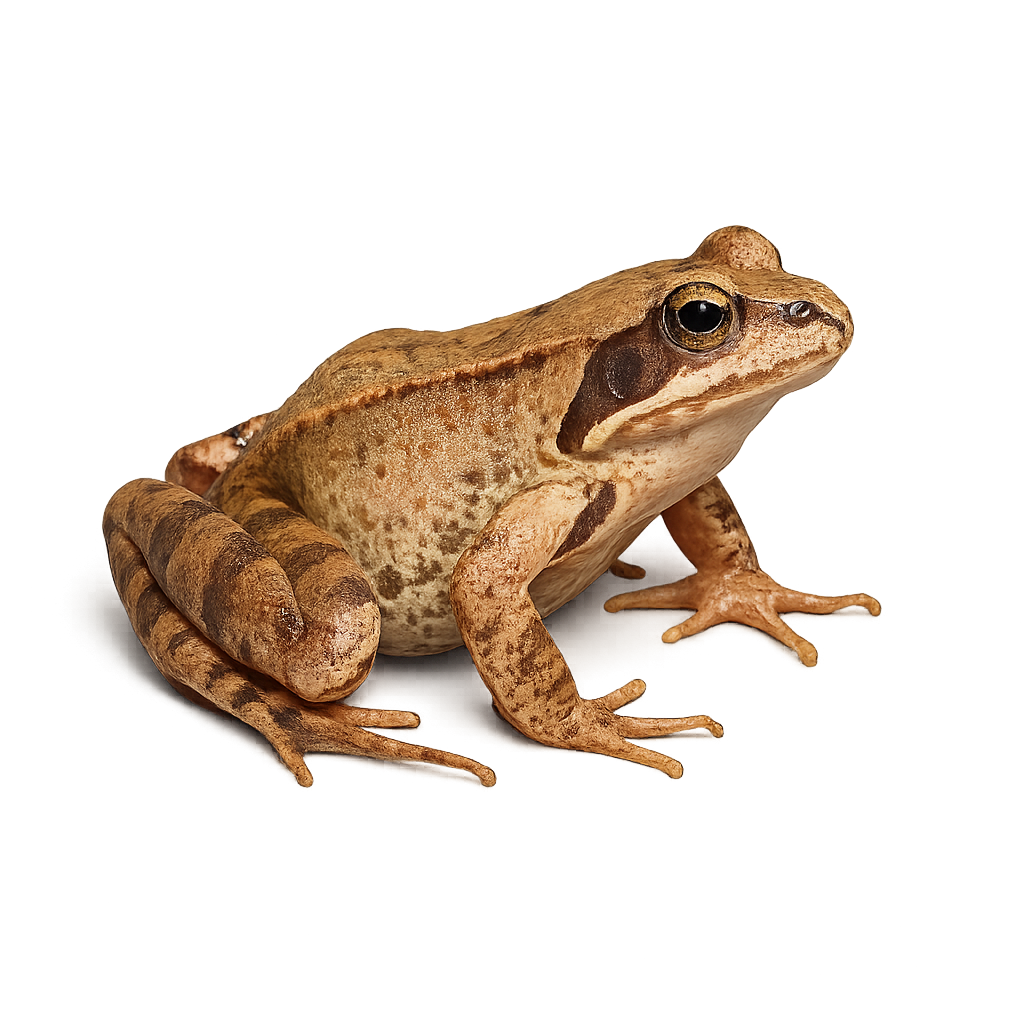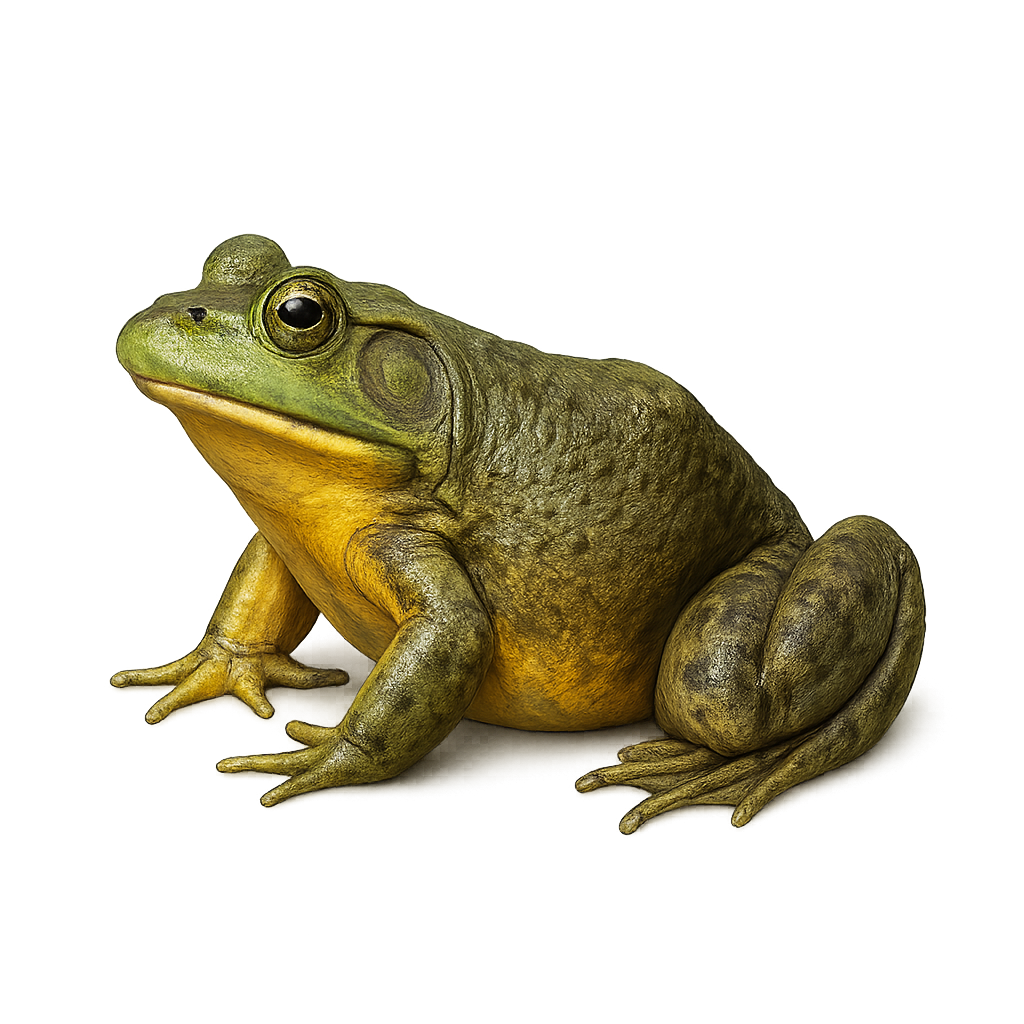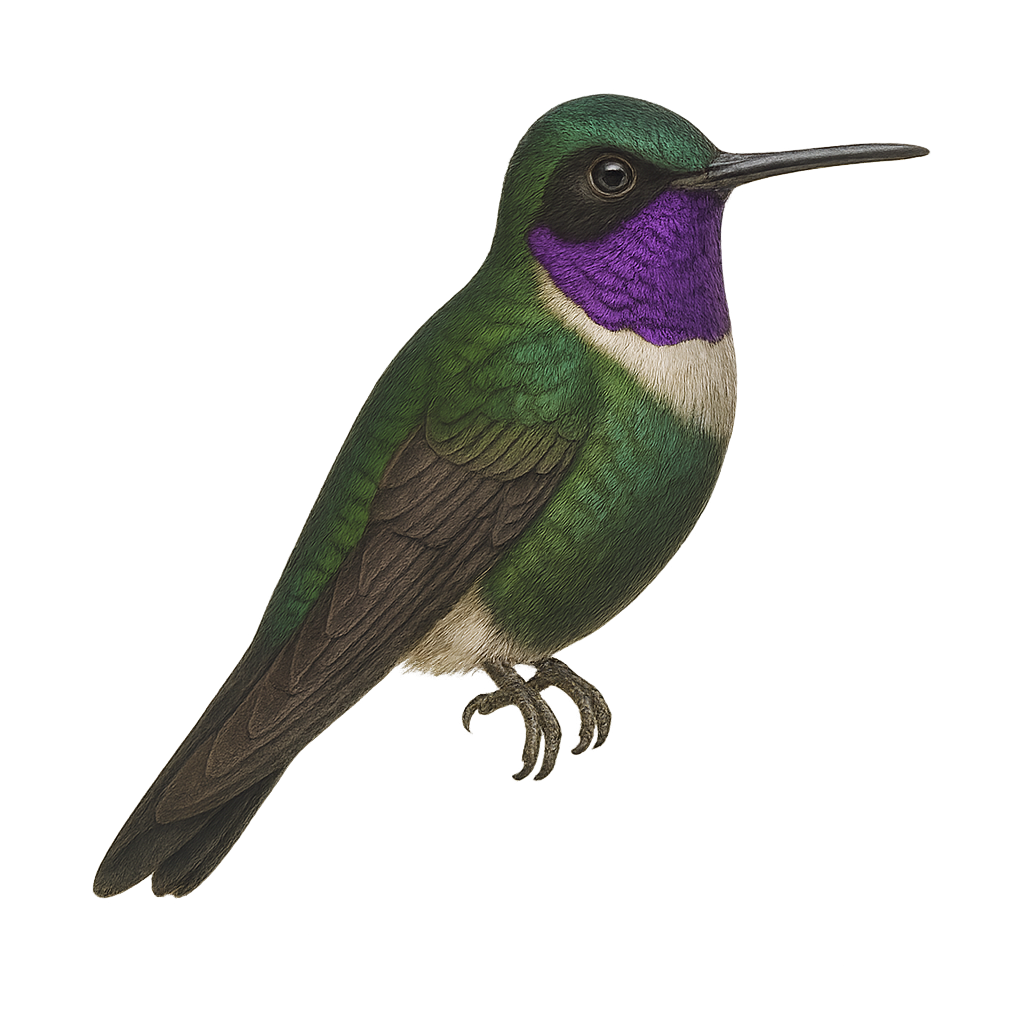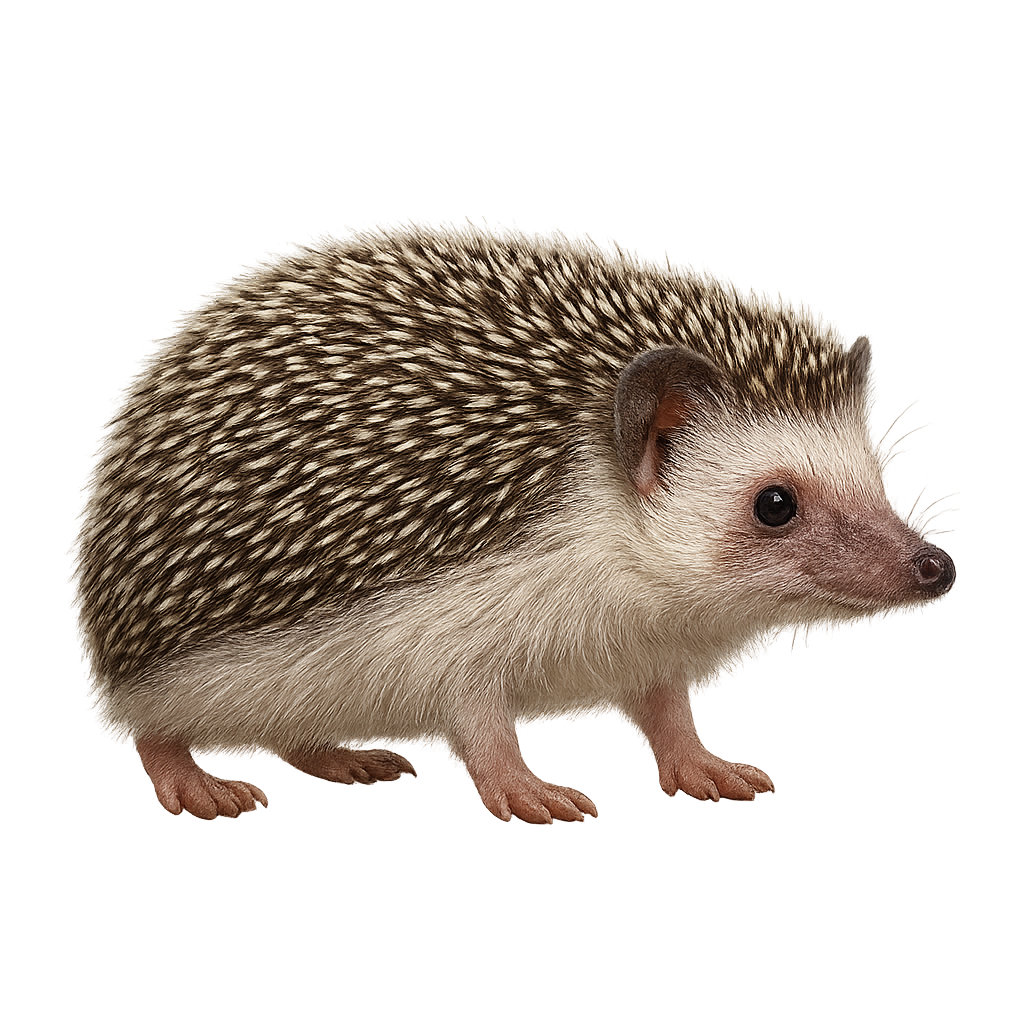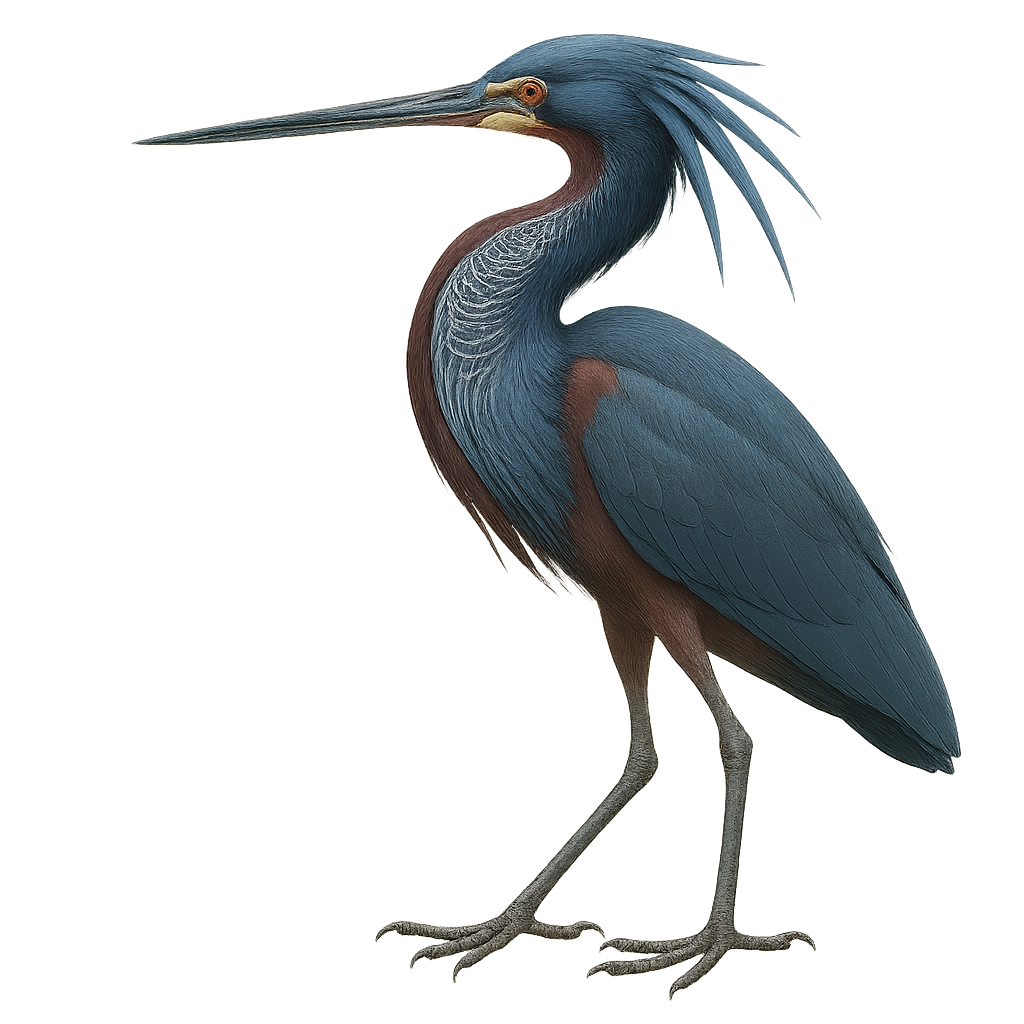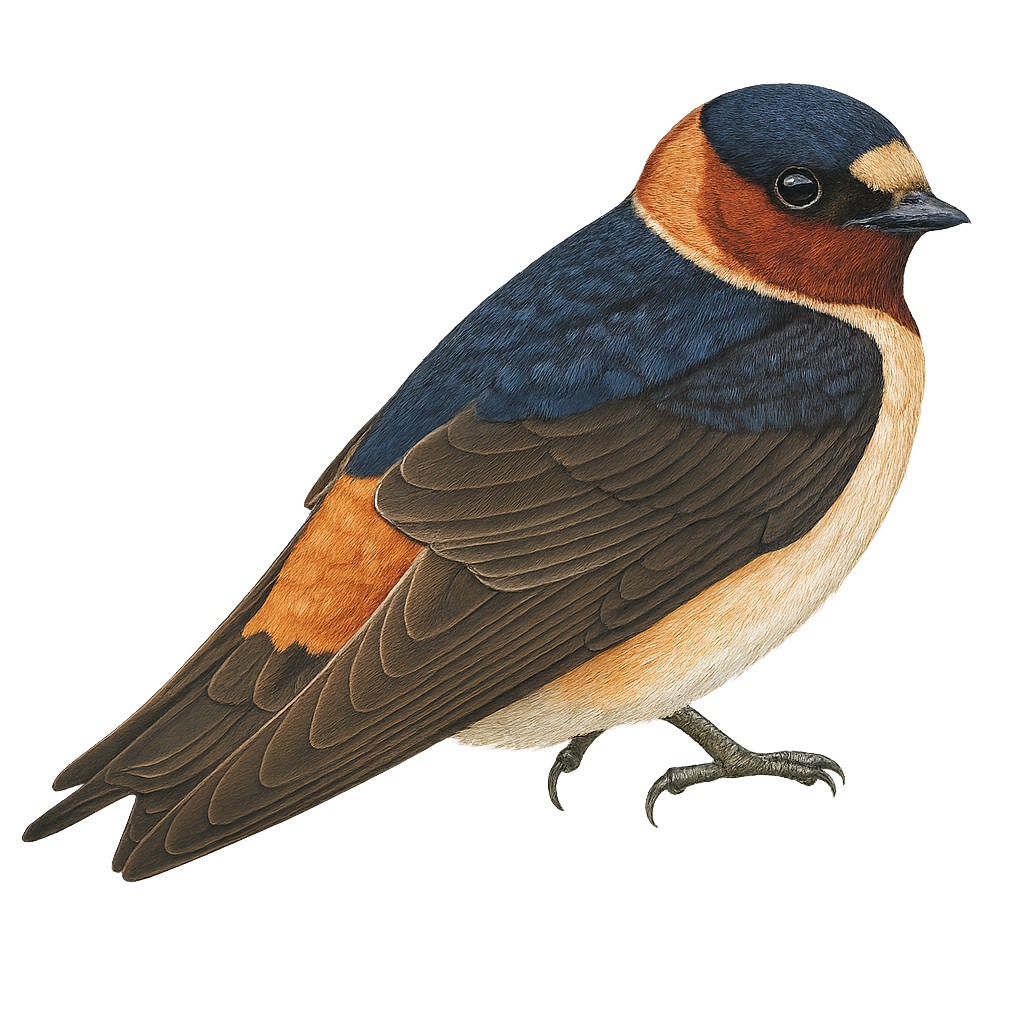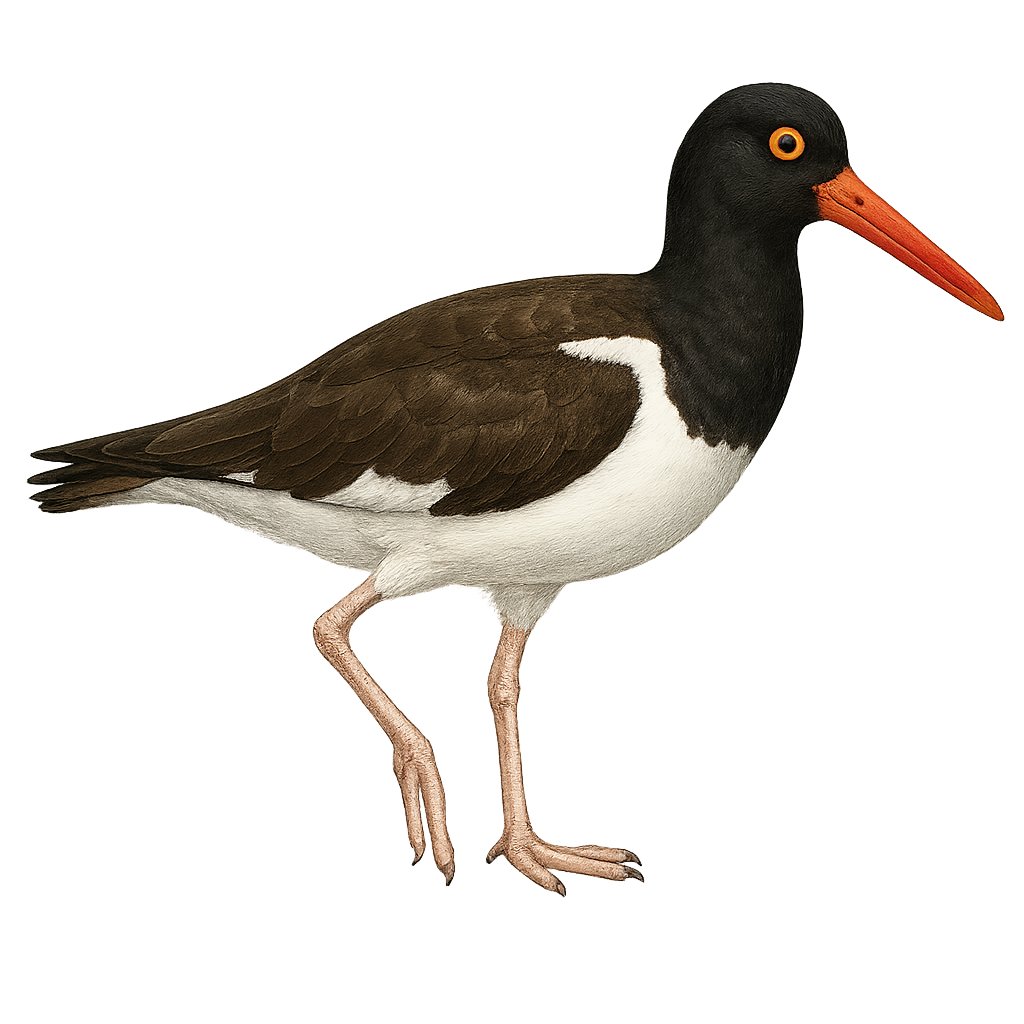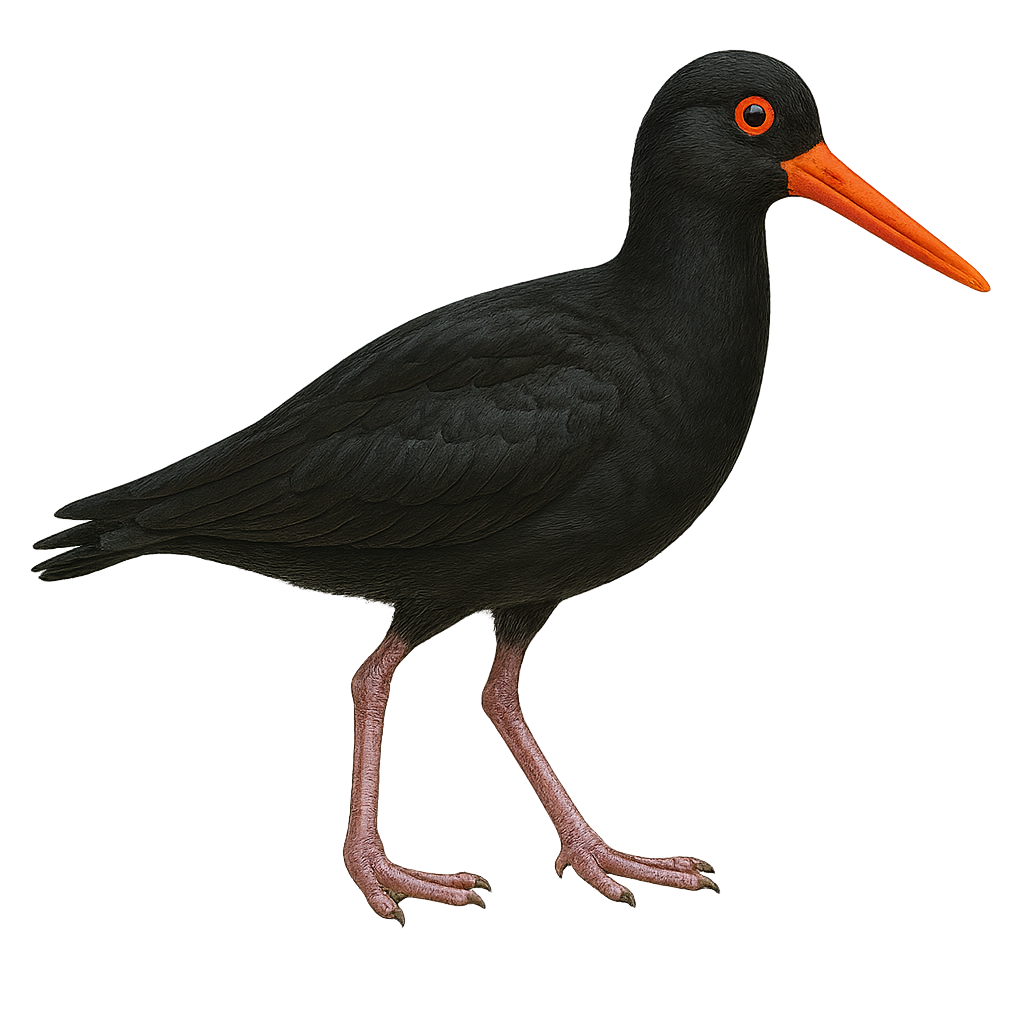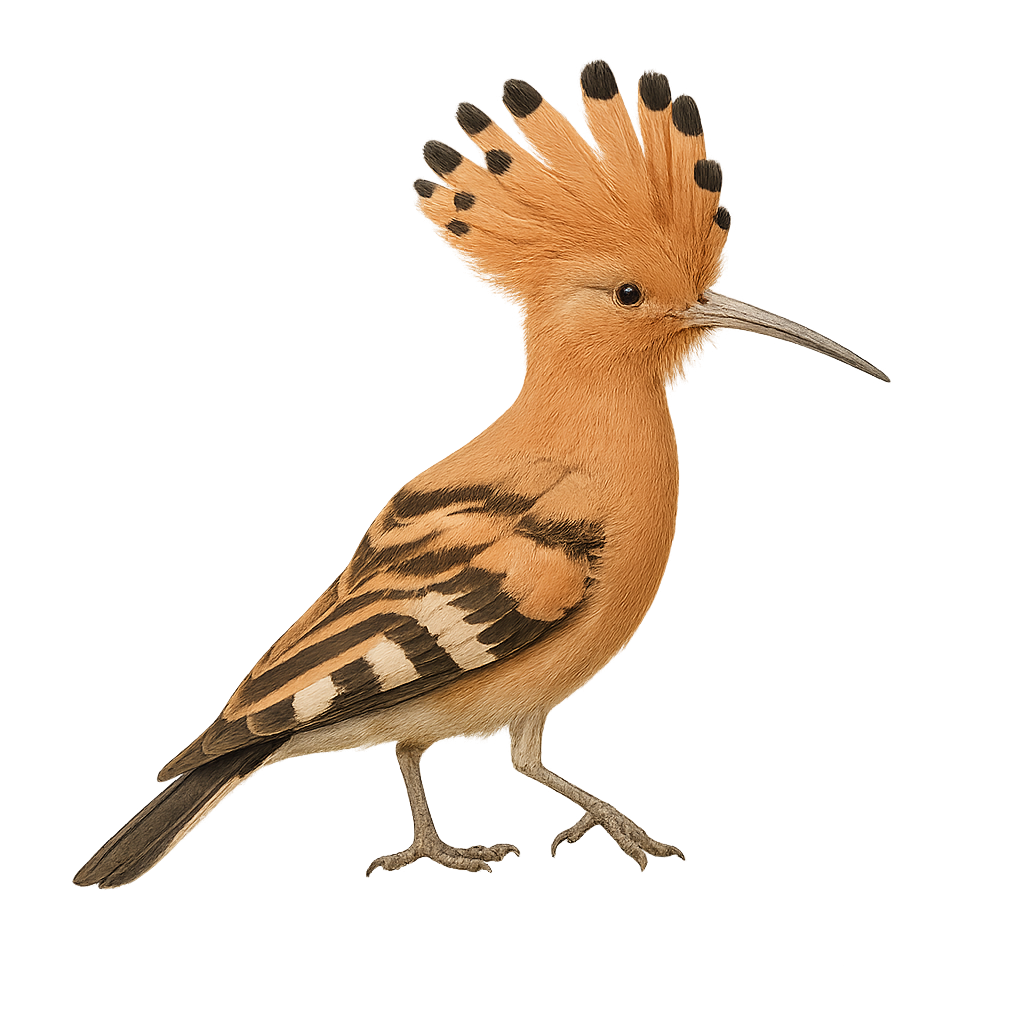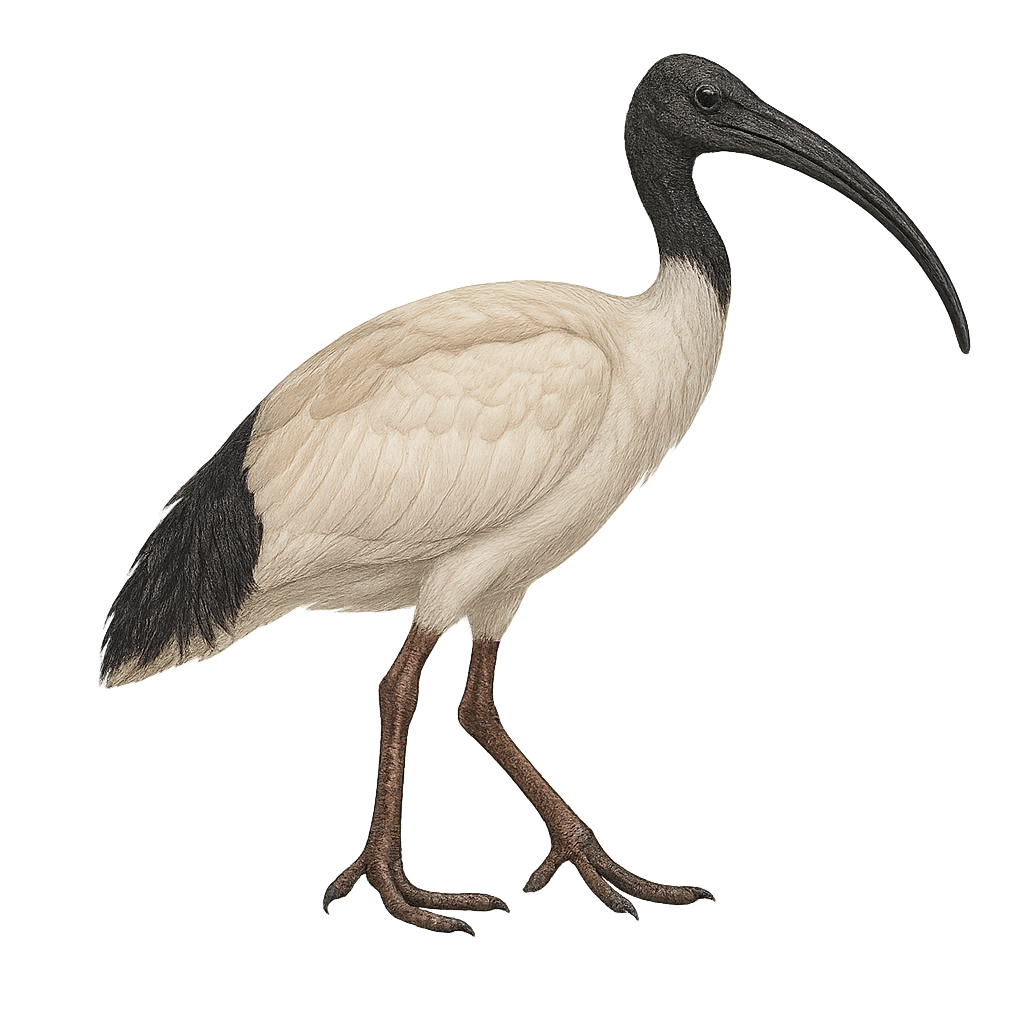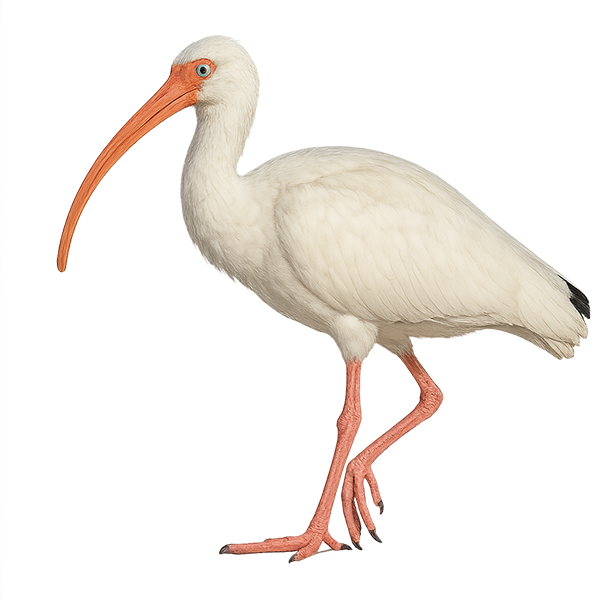
The Asian Elephant is a large land mammal, known for its imposing size and large rounded ears. It typically stands between 2 and 3.5 meters at the withers and weighs between 2,000 and 5,000 kg. Its coat is generally grayish, although some individuals may have a more brownish tint. The Asian Elephant differs from the African Elephant in its smaller size, narrower ears, and its trunk, which has a single "finger" at the tip. This elephant primarily inhabits tropical forests, savannas, and wetland areas in South and Southeast Asia, including India, Thailand, Sri Lanka, and Cambodia. It is herbivorous, feeding on leaves, bark, fruits, and grasses. The Asian Elephant has often been associated with human communities due to its historical role in labor, transport, and religious ceremonies. However, the species is threatened by habitat loss due to agriculture, poaching for its valuable tusks, and conflicts with human populations. It is listed as endangered by the International Union for Conservation of Nature (IUCN).
The Forest Elephant is a large land mammal, characterized by its smaller size compared to the Asian Elephant and the African Savannah Elephant, standing around 2 to 3 meters at the withers and weighing between 2,000 and 5,000 kg. Its coat is gray, but its skin is often rougher than other elephants, and its ears are smaller, adapted to its forest habitat. The Forest Elephant primarily inhabits the dense forests of Central and West Africa, where it feeds on a wide variety of vegetation, including leaves, bark, fruits, and roots. Unlike the Savannah Elephant, it is more discreet and less social, though it may form small family groups. This elephant plays a key role in its ecosystem, contributing to seed dispersal and forest regeneration. However, the species is threatened by deforestation, poaching for its valuable tusks, and conflicts with human communities. It is currently listed as vulnerable by the International Union for Conservation of Nature (IUCN).
The Aplomado Falcon, Falco femoralis, is a sleek and slender raptor, recognizable by its distinctive plumage. It features a slate-gray back, a white belly, and a black band across the chest. Its wings are long and pointed, adapted for fast and agile flights. This falcon is primarily found in open grasslands, savannas, and semi-desert areas of Central and South America. A skilled predator, it mainly feeds on small birds, rodents, and insects. Although its habitat is vast, it is sometimes threatened by the loss of its natural environment. Its behavior is generally suspicious, but it can become accustomed to human presence in some areas.
The alpine warbler is a small passerine of 12–13 cm with olive-brown, faintly streaked plumage and buff flanks. It inhabits alpine heath, subalpine meadows and open coniferous woodland. It feeds mainly on insects and spiders captured in vegetation. During breeding, males sing in flight or from elevated perches to attract females.
The Andean flamingo is a rare species of flamingo that inhabits saline and alkaline lagoons of the high Andes plateaus, primarily in Argentina, Chile, and Bolivia. It is distinguished by its white plumage and pale pink hues, as well as its graceful silhouette. This species is threatened by habitat loss and human disturbance and is listed as a protected species. It primarily feeds on algae and small crustaceans found in saline waters.
The Australasian Gannet, or Morus serrator, is a striking seabird known for its brilliant white plumage, black-tipped wings, and pale blue bill. It primarily inhabits the coasts of Australia and New Zealand. This bird is famous for its spectacular dives, reaching speeds of 100 km/h to catch fish. Australasian Gannets are social birds, often seen in large colonies on rocky islands. They nest on cliffs or islets, usually laying a single egg. Although they are quite tolerant of human presence, it's essential to respect their space to avoid disturbing their natural behavior.
The Abbott's Booby, or Papasula abbotti, is a rare and iconic seabird found in the Indian Ocean, particularly on Christmas Island. It is recognizable by its striking white plumage contrasted with black wings and tail, and it has a robust, slightly curved beak. Unusually for a booby, it nests primarily in the trees of the rainforest. Its population is declining due to deforestation and human disturbances. The Abbott's Booby feeds mainly on fish and squid, which it captures by skillfully diving into the ocean. Conservation efforts are crucial to maintaining the ecological balance of its island habitat.
The American Coot is a medium-sized waterbird, easily identified by its slate-gray plumage and distinctive white bill, often marked with a red spot at the base. It inhabits lakes, ponds, and marshes across North America, feeding primarily on aquatic vegetation, insects, and small fish. Although often mistaken for a duck, it belongs to the rail family. It has strong legs and long lobed toes that enable it to swim and walk on floating vegetation. The American Coot is known for its territorial behavior, especially during the breeding season, when it vigorously defends its territory against intruders.
The Ascension Frigatebird, scientifically known as Fregata aquila, is an impressive seabird renowned for its ability to fly long distances without landing. It boasts a wingspan of up to 2.3 meters, allowing it to effortlessly glide over oceans. Its plumage is predominantly black with metallic sheen, and males display a bright red gular pouch that they inflate to attract females. These birds primarily nest on Ascension Island, where they form large colonies. They mainly feed on fish and squid, which they skillfully snatch from the water. Their lifestyle is closely tied to ocean currents and climatic conditions, making them vulnerable to environmental changes.
The Audouin's Gull, Larus audouinii, is a rare and elegant gull species primarily found in the Mediterranean basin. Recognizable by its pure white plumage, light gray wings, and bright red bill with a black tip, it stands out with its slender silhouette and graceful demeanor. This gull mainly nests on rocky islands and isolated coasts, forming dense colonies. It primarily feeds on fish, skillfully diving into the water to catch its prey. Although its population experienced a significant decline in the 20th century, conservation efforts have led to some stabilization. However, it remains vulnerable to human disturbances and environmental changes.
The Australasian Grebe, or Tachybaptus novaehollandiae, is a small waterbird found mainly in Australia and New Guinea. It is recognizable by its dark brown plumage, black throat, and short, pointed bill. During the breeding season, a bright yellow patch appears at the base of its bill. This grebe prefers freshwater bodies such as lakes and ponds, where it feeds on small fish, aquatic insects, and crustaceans. It is an excellent swimmer and diver, capable of staying underwater for extended periods to hunt its food. Although generally discreet, it can be seen swimming on the surface or hiding among reeds.
Xenopus laevis is a fully aquatic amphibian native to sub-Saharan Africa, identifiable by its smooth olive skin and four claws on the front feet. It inhabits ponds, pools, and ditches of still water, feeding on invertebrates and small fish with its fast, sticky tongue.
The Azureus Poison Dart Frog is a brightly colored and striking species, known for its vivid blue color that varies in intensity. Native to the humid tropical forests of Guyana, Suriname, and Brazil, it is famous for its camouflage abilities and skin glands that secrete potent toxins, used for defense against predators. This frog is primarily terrestrial and lives in areas near streams and swamps, where it feeds on insects and other small prey. Due to its coloration, it serves as a warning signal to predators. It is primarily diurnal.
The Anchicayé Poison Frog, Oophaga anchicayensis, is a species of frog endemic to the humid tropical forests of Colombia. Known for its bright coloration, ranging from red to blue, it serves as a warning signal to potential predators. This small frog typically measures between 2 and 3 cm in length and feeds primarily on small insects and arthropods. Like other members of the Dendrobatidae family, it possesses potent skin toxins used as a defense mechanism. The Anchicayé Poison Frog is often found in moist undergrowth, moving slowly in search of food. Its reproduction is complex, involving the transport of tadpoles by parents to suitable aquatic sites.
The agile frog is a small terrestrial frog of 6–8 cm with light brownish-red dorsal coloration and pale throat, equipped with strong hind legs. It inhabits open woodland edges, damp meadows and hedgerows, feeding on insects and spiders. During the breeding season, males call from the water’s edge to attract females into shallow water.
The American Bullfrog, Lithobates catesbeianus, is a species of frog native to North America. Known for its large size, it can reach up to 20 cm in length and weigh over 500 grams. Its skin is typically green or brown with darker spots, and it has powerful hind legs adapted for jumping and swimming. This frog is often found near stagnant water bodies like ponds, marshes, and lakes. It is famous for its loud, deep call that resembles a bull's bellow, hence its name. An opportunistic feeder, it consumes a variety of insects, small fish, and even small birds and mammals.
The Alto de Buey Poison Frog is a small, brightly colored frog endemic to the tropical forests of Colombia. Its skin features vivid red and black hues, serving as a natural warning of its toxicity. This species is primarily terrestrial and is often found on the moist forest floor, where it feeds on small insects. It plays a crucial role in the ecosystem by regulating insect populations. Unfortunately, it is threatened by deforestation and habitat loss. Its reproduction is complex, involving parental care where adults transport tadpoles to water bodies.
The Asiatic cheetah, or Iranian cheetah, is a rare subspecies of cheetah primarily found in Iran. It is distinguished by its tawny coat with black spots and its slender, speed-adapted body. This feline is a symbol of Iranian wildlife but is critically endangered due to habitat loss, hunting, and a decrease in natural prey. Conservation efforts focus on habitat protection and raising awareness among local communities. The Asiatic cheetah is a diurnal hunter, using its incredible speed to catch prey such as gazelles and hares.
The Arabian Green Bee-eater, Merops cyanophrys, is a medium-sized, colorful bird, measuring about 28 cm in length. It is easily recognizable by its bright green plumage, pale blue cheeks, and vivid yellow throat. This elegant bird is often observed in flight, catching insects mid-air with its agile aerial maneuvers. It frequents open areas, savannas, and semi-arid regions, often near water. A migratory species, it breeds in southern Europe and western Asia, then migrates to sub-Saharan Africa for the winter. The Arabian Green Bee-eater is a sociable bird, often seen in groups, and nests in burrows dug into sandy banks.
The Asian Green Bee-eater, or Merops orientalis, is a vibrant and graceful bird, easily recognized by its bright green plumage, blue throat, and black eye stripe. Measuring about 23 cm in length, it has a slender, slightly curved beak, perfect for catching insects in flight. This bird is often seen in small groups, perching on exposed branches to watch for prey. It is particularly common in open regions, savannas, and agricultural areas. The Asian Green Bee-eater is a partial migrant, moving according to the seasons to find food resources. Its presence is an indicator of the health of local ecosystems.
The Heliangelus amethysticollis, or Amethyst-throated Sunangel, is a captivating small bird from the Trochilidae family. This hummingbird is distinguished by its striking violet throat, which beautifully contrasts with its metallic green plumage. It is primarily found in the humid forests of the Andes, at altitudes ranging from 1800 to 3000 meters. Its slender, slightly curved beak is perfectly adapted for feeding on flower nectar, which it gathers with remarkable agility. In addition to its nectarivorous diet, it also consumes small insects to supplement its nutrition. The Amethyst-throated Sunangel is a territorial bird, often observed vigorously defending its territory against other hummingbirds. Its breeding season generally extends from November to March, and the female builds a cup-shaped nest where she lays two eggs.
The African Pygmy Hedgehog, scientifically known as Atelerix albiventris, is a small insectivorous mammal native to sub-Saharan Africa. It is easily identifiable by its spiny back and white belly. This hedgehog measures about 15 to 25 cm in length and weighs between 300 and 600 grams. Primarily nocturnal, it feeds on insects, small invertebrates, and occasionally fruits. In captivity, it is often kept as a pet due to its compact size and generally docile nature. However, it requires specific care, including a suitable habitat and balanced diet to remain healthy.
The Agami Heron, or Agamia agami, is a unique and fascinating heron known for its exceptionally colorful plumage and slender silhouette. This large bird, measuring about 66 to 76 cm in length, sports a plumage with varied hues ranging from deep blue to brown, with metallic reflections. Its neck is long and thin, often folded in an S-shape, and its beak is sharp, ideal for capturing aquatic prey. The Agami Heron is primarily observed in the humid tropical forests of Central and South America, where it frequents rivers and swamps. Discreet and solitary, it is often difficult to spot, preferring to move slowly and silently through dense vegetation.
The American Cliff Swallow, Petrochelidon pyrrhonota, is a small migratory bird belonging to the Hirundinidae family. It is easily recognizable by its distinctive white forehead, dark blue back, and beige belly. These swallows are often seen in large groups, nesting under bridges, ledges, and cliffs. They build gourd-shaped nests using mud and saliva. Their diet mainly consists of flying insects, which they catch in mid-air. They are highly social and communicate through various songs and calls. Their range extends from North America to South America, where they spend the winter.
The American Oystercatcher is a coastal bird known for its distinctive black and white plumage, bright red bill, and yellow-ringed eyes. It primarily inhabits sandy beaches, mudflats, and estuaries where it feeds mainly on bivalve mollusks, which it skillfully opens with its strong bill. This bird is often seen in small groups but can also be solitary. It is known for its loud, piercing calls, especially during the breeding season. The American Oystercatcher is a partial migrant, with some populations moving south in winter. Its presence is an indicator of healthy coastal ecosystems, although it is threatened by habitat loss and human disturbances.
The African Black Oystercatcher is a coastal bird endemic to the South African coastline, easily identified by its black plumage, bright red bill, and red-ringed eyes. It primarily inhabits sandy beaches and rocky shores, feeding on mollusks and crustaceans. This bird is monogamous, forming stable pairs that vigorously defend their territory. Nesting occurs on the ground, often near the sea, with both parents sharing incubation and chick-rearing duties. Although its population is stable, it remains vulnerable to human disturbances and predation by introduced species.
The African Hoopoe, or Upupa epops africana, is a captivating bird, easily identified by its distinctive crest and black-and-white plumage patterns. It primarily inhabits the savannas and wooded areas of sub-Saharan Africa. This bird feeds mainly on insects, which it captures with its long, slender beak. The African Hoopoe is often seen probing the ground for food and is known for its distinctive "hoo-hoo-hoo" call. While generally solitary, it can be observed in small groups during the breeding season. Its adaptability to various habitats makes it a resilient species, although habitat loss remains a potential threat.
The Australian White Ibis, or Threskiornis molucca, is a medium-sized bird easily recognizable by its white plumage contrasting with its black neck and head. Its long, curved beak is perfectly adapted for probing the ground in search of food. This bird is often seen in wetlands, marshes, and estuaries, but it has also adapted well to urban environments. Known for its gregarious behavior, it forms large colonies during the breeding season. Although its appearance may seem austere, the Australian White Ibis plays a crucial role in the ecosystem by controlling insect populations and cleaning up organic waste. Its ability to adapt to various habitats makes it a resilient species, although its interaction with humans can sometimes be a source of conflict.
The American White Ibis, Eudocimus albus, is an elegant and graceful bird found mainly in wetlands and coastal areas of the Americas. It is easily recognizable by its bright white plumage, long curved reddish bill, and red legs. Adults measure about 65 cm in length with a wingspan of 95 cm. They primarily feed on small aquatic invertebrates, which they capture by probing the mud with their bill. American White Ibises live in colonies and are often seen in large groups. Their flight is characterized by regular wing beats and gliding. Although they are mainly diurnal, they can be active at dawn and dusk.
The Australian Ibis, or Threskiornis spinicollis, is a large wading bird easily recognized by its bare black head, long down-curved bill, and straw-colored feathers hanging from its breast. Its plumage is strikingly contrasted: the back and wings are bluish-black with iridescent reflections, while the neck, nape, and underparts are white. It inhabits wetlands, flooded meadows, and farmlands across Australia and New Guinea. It feeds on frogs, insects, small reptiles, and worms. Often seen in flocks, it breeds in colonies in trees near water. The species is widespread and well adapted to open environments.



